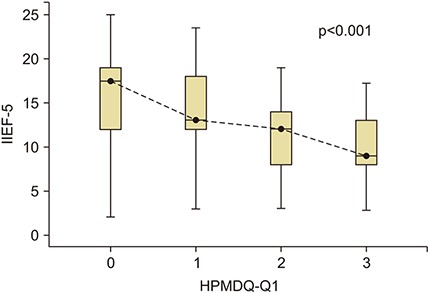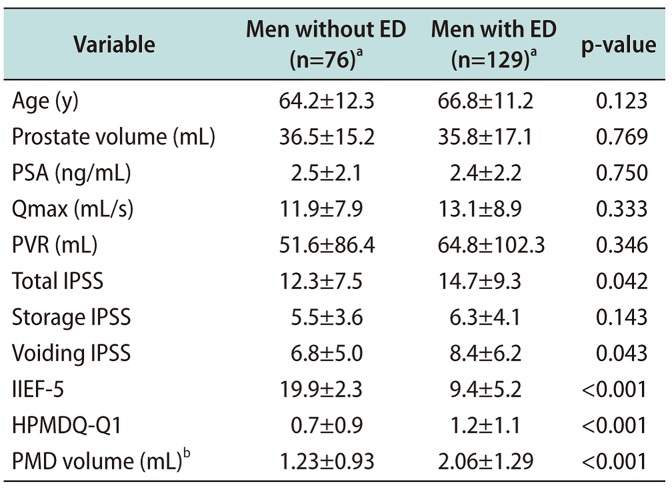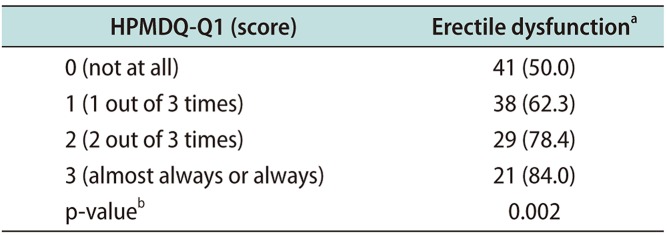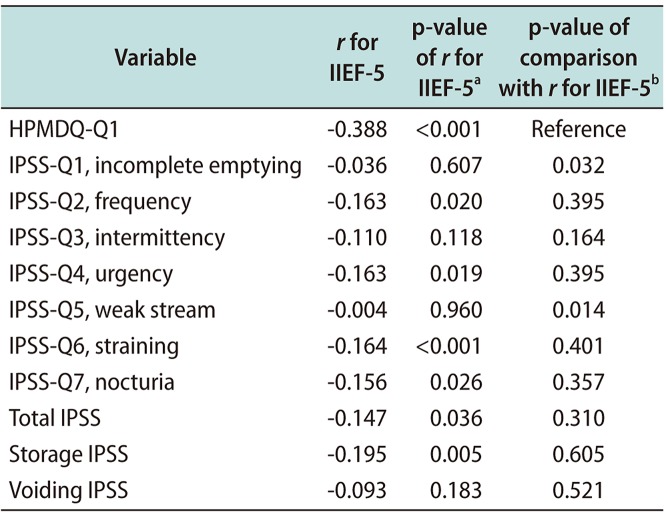1. De Nunzio C, Roehrborn CG, Andersson KE, McVary KT. Erectile dysfunction and lower urinary tract symptoms. Eur Urol Focus. 2017; 3:352–363. PMID:
29191671.

2. Gratzke C, Bachmann A, Descazeaud A, Drake MJ, Madersbacher S, Mamoulakis C, et al. EAU guidelines on the assessment of non-neurogenic male lower urinary tract symptoms including benign prostatic obstruction. Eur Urol. 2015; 67:1099–1109. PMID:
25613154.

3. Hatzimouratidis K, Amar E, Eardley I, Giuliano F, Hatzichristou D, Montorsi F, et al. Guidelines on male sexual dysfunction: erectile dysfunction and premature ejaculation. Eur Urol. 2010; 57:804–814. PMID:
20189712.

4. Ryu JK, Cho KS, Kim SJ, Oh KJ, Kam SC, Seo KK, et al. Korean society for sexual medicine and andrology (KSSMA) guideline on erectile dysfunction. World J Mens Health. 2013; 31:83–102. PMID:
24044105.

5. Pöyhönen A, Auvinen A, Koskimäki J, Hakama M, Tammela TL, Häkkinen JT. Prevalence and bother of postmicturition dribble in finnish men aged 30–80 years: tampere ageing male urologic study (TAMUS). Scand J Urol Nephrol. 2012; 46:418–423. PMID:
22835055.

6. Agarwal A, Eryuzlu LN, Cartwright R, Thorlund K, Tammela TL, Guyatt GH, et al. What is the most bothersome lower urinary tract symptom? Individual- and population-level perspectives for both men and women. Eur Urol. 2014; 65:1211–1217. PMID:
24486308.

7. Abrams P, Cardozo L, Fall M, Griffiths D, Rosier P, Ulmsten U, et al. The standardisation of terminology in lower urinary tract function: report from the standardisation Sub-committee of the International Continence Society. Urology. 2003; 61:37–49. PMID:
12559262.

8. Stephenson TP, Farrar DJ. Urodynamic study of 15 patients with postmicturition dribble. Urology. 1977; 9:404–406. PMID:
558674.

9. Wille S, Mills RD, Studer UE. Absence of urethral post-void milking: an additional cause for incontinence after radical prostatectomy? Eur Urol. 2000; 37:665–669. PMID:
10828665.
10. Shafik A, Shafik IA, El Sibai O, Shafik AA. Study of the response of the penile corporal tissue and cavernosus muscles to micturition. BMC Urol. 2008; 8:4. PMID:
18312692.

11. Ferrer JE, Velez JD, Herrera AM. Age-related morphological changes in smooth muscle and collagen content in human corpus cavernosum. J Sex Med. 2010; 7:2723–2728. PMID:
19796056.

12. Costa C, Vendeira P. Does erectile tissue angioarchitecture modify with aging? An immunohistological and morphometric approach. J Sex Med. 2008; 5:833–840. PMID:
18221283.

13. Macfarlane GJ, Botto H, Sagnier PP, Teillac P, Richard F, Boyle P. The relationship between sexual life and urinary condition in the French community. J Clin Epidemiol. 1996; 49:1171–1176. PMID:
8826998.

14. Frankel SJ, Donovan JL, Peters TI, Abrams P, Dabhoiwala NF, Osawa D, et al. Sexual dysfunction in men with lower urinary tract symptoms. J Clin Epidemiol. 1998; 51:677–685. PMID:
9743316.

15. Barry MJ, Fowler FJ Jr, O'Leary MP, Bruskewitz RC, Holtgrewe HL, Mebust WK, et al. The American Urological Association symptom index for benign prostatic hyperplasia. The measurement Committee of the American Urological Association. J Urol. 1992; 148:1549–1557. discussion 1564. PMID:
1279218.
16. Ahn TY, Lee DS, Kang WC, Hong JH, Kim YS. Validation of an abridged Korean version of the international index of erectile function (IIEF-5) as a diagnostic tool for erectile dysfunction. Korean J Urol. 2001; 42:535–540.
17. Rosen RC. Update on the relationship between sexual dysfunction and lower urinary tract symptoms/benign prostatic hyperplasia. Curr Opin Urol. 2006; 16:11–19. PMID:
16385195.

18. Terai A, Ichioka K, Matsui Y, Yoshimura K. Association of lower urinary tract symptoms with erectile dysfunction in Japanese men. Urology. 2004; 64:132–136. PMID:
15245950.

19. Ponholzer A, Temml C, Obermayr R, Madersbacher S. Association between lower urinary tract symptoms and erectile dysfunction. Urology. 2004; 64:772–776. PMID:
15491718.

20. Morant S, Bloomfield G, Vats V, Chapple C. Increased sexual dysfunction in men with storage and voiding lower urinary tract symptoms. J Sex Med. 2009; 6:1103–1110. PMID:
19138377.

21. Sexton CC, Coyne KS, Kopp ZS, Irwin DE, Milsom I, Aiyer LP, et al. The overlap of storage, voiding and postmicturition symptoms and implications for treatment seeking in the USA, UK and Sweden: EpiLUTS. BJU Int. 2009; 103(Suppl 3):12–23. PMID:
19302498.

22. Irwin DE, Milsom I, Hunskaar S, Reilly K, Kopp Z, Herschorn S, et al. Population-based survey of urinary incontinence, overactive bladder, and other lower urinary tract symptoms in five countries: results of the EPIC study. Eur Urol. 2006; 50:1306–1314. discussion 1314–5. PMID:
17049716.

23. Coyne KS, Sexton CC, Thompson CL, Milsom I, Irwin D, Kopp ZS, et al. The prevalence of lower urinary tract symptoms (LUTS) in the USA, the UK and Sweden: results from the epidemiology of LUTS (EpiLUTS) study. BJU Int. 2009; 104:352–360. PMID:
19281467.

24. Koskimäki J, Hakama M, Huhtala H, Tammela TL. Prevalence of lower urinary tract symptoms in finnish men: a population-based study. Br J Urol. 1998; 81:364–369. PMID:
9523653.
25. Pöyhönen A, Auvinen A, Häkkinen JT, Koskimäki J, Tammela TL. Population-level and individual-level bother of lower urinary tract symptoms among 30- to 80-year-old men. Urology. 2016; 95:164–170. PMID:
27349526.

26. Hald T, Nordling J, Andersen JT, Bilde T, Meyhoff HH, Walter S. A patient weighted symptom score system in the evaluation of uncomplicated benign prostatic hyperplasia. Scand J Urol Nephrol Suppl. 1991; 138:59–62. PMID:
1723812.
27. Engström G, Walker-Engström ML, Henningsohn L, Lööf L, Leppert J. Prevalence of distress and symptom severity from the lower urinary tract in men: a population-based study with the DAN-PSS questionnaire. Fam Pract. 2004; 21:617–622. PMID:
15465878.
28. Adegun PT, Areo PO, Solomon A, Dada SA, Adebayo PB. Erectile dysfunction in men with and without lower urinary tract symptoms in Nigeria. World J Mens Health. 2017; 35:107–114. PMID:
28868819.

29. Park HJ, Won JE, Sorsaburu S, Rivera PD, Lee SW. Urinary tract symptoms (LUTS) secondary to benign prostatic hyperplasia (BPH) and LUTS/BPH with erectile dysfunction in Asian men: a systematic review focusing on tadalafil. World J Mens Health. 2013; 31:193–207. PMID:
24459652.









 PDF
PDF ePub
ePub Citation
Citation Print
Print



 XML Download
XML Download